Differentiated Climate Drivers of Carbon and Water Use Efficiencies Across Land Use Types in the Yellow River Basin, China
Abstract
1. Introduction
- Characterize the spatiotemporal variation patterns of CUE and WUE.
- Investigate the effects of major climatic variables.
- Perform a comparative assessment of how CUE and WUE respond to these variables under various land use types.
2. Literature Review
3. Materials and Methods
3.1. Study Area
3.2. Data Sources and Processing
3.2.1. Data Selection and Sources
3.2.2. Data Processing and Verification
3.3. Methods
3.3.1. Calculations of WUE and CUE
3.3.2. Methodology for Trend Analysis
3.3.3. Partial Correlation Analysis
3.3.4. Relative Contribution of MAT, MAP, and SR to NPP, GPP, WUE, and CUE
4. Results
4.1. Spatiotemporal Evolution Characteristics
4.1.1. Spatial Distribution Characteristics
4.1.2. Temporal Evolution Characteristics
4.1.3. Trends Characteristics
4.2. Effects of MAT, MAP, and SR on GPP, NPP, WUE, and CUE
4.2.1. Partial Correlation Coefficients of Climate Factors
4.2.2. Relative Contributions
4.3. GPP, NPP, WUE, and CUE of Different Land Use Types
4.3.1. Mean Changes for Different Land Use Types
4.3.2. Partial Correlation Coefficients of MAT, MAP, and SR Under Different Land Use Types
4.3.3. Relative Contributions Under Different Land Use Types
5. Discussion
5.1. Changes in the Spatiotemporal Distribution
5.2. Responses of WUE and CUE to Climatic Factors
5.3. Differences in CUE and WUE Across Land Use Types
5.4. Policy Impact and Implications
5.5. Research Contributions and Limitations
6. Conclusions
Author Contributions
Funding
Data Availability Statement
Conflicts of Interest
Appendix A
Appendix A.1. Sampling Points
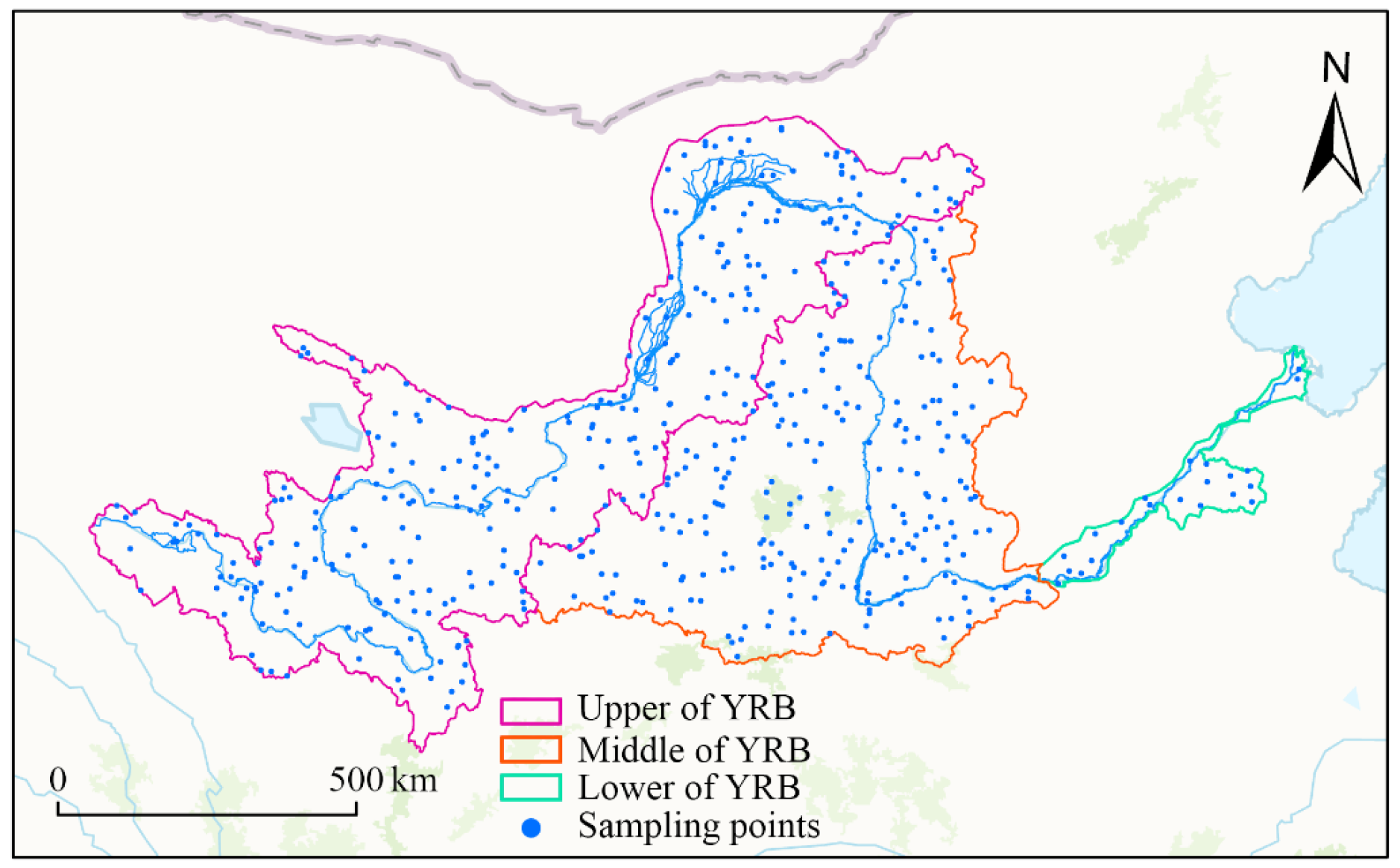
Appendix A.2. Results of the Partial Correlation Coefficients

References
- Gang, C.; Zhang, Y.; Guo, L.; Gao, X.; Peng, S.; Chen, M.; Wen, Z. Drought-Induced Carbon and Water Use Efficiency Responses in Dryland Vegetation of Northern China. Front. Plant Sci. 2019, 10, 224. [Google Scholar] [CrossRef]
- United Nations. Transforming Our World: The 2030 Agenda for Sustainable Development; United Nations: New York, NY, USA, 2015. [Google Scholar]
- DeLUCIA, E.H.; Drake, J.E.; Thomas, R.B.; Gonzalez-Meler, M. Forest Carbon Use Efficiency: Is Respiration a Constant Fraction of Gross Primary Production? Glob. Change Biol. 2007, 13, 1157–1167. [Google Scholar] [CrossRef]
- Ito, A.; Inatomi, M. Water-Use Efficiency of the Terrestrial Biosphere: A Model Analysis Focusing on Interactions between the Global Carbon and Water Cycles. J. Hydrometeorol. 2012, 13, 681–694. [Google Scholar] [CrossRef]
- Shao, W.; Guan, Q.; Liu, H.; Sun, W.; Sun, Y. Temporal and Spatial Dynamics of Carbon and Water Use Efficiency on the Qinghai-Tibet Plateau and Their Ecosystem Responses. J. Clean. Prod. 2024, 475, 143581. [Google Scholar] [CrossRef]
- Prieto, I.; León-Sánchez, L.; Nicolás, E.; Nortes, P.; Querejeta, J.I. Warming Reduces Both Photosynthetic Nutrient Use Efficiency and Water Use Efficiency in Mediterranean shrubs Warming Reduces Nutrient Use Efficiency. Environ. Exp. Bot. 2023, 210, 105331. [Google Scholar] [CrossRef]
- Ji, Y.; Li, Y.; Yao, N.; Biswas, A.; Zou, Y.; Meng, Q.; Liu, F. The Lagged Effect and Impact of Soil Moisture Drought on Terrestrial Ecosystem Water Use Efficiency. Ecol. Indic. 2021, 133, 108349. [Google Scholar] [CrossRef]
- Chen, G.; Zuo, D.; Xu, Z.; Wang, G.; Han, Y.; Peng, D.; Pang, B.; Abbaspour, K.C.; Yang, H. Changes in Water Conservation and Possible Causes in the Yellow River Basin of China during the Recent Four Decades. J. Hydrol. 2024, 637, 131314. [Google Scholar] [CrossRef]
- Cai, W.; Ullah, S.; Yan, L.; Lin, Y. Remote Sensing of Ecosystem Water Use Efficiency: A Review of Direct and Indirect Estimation Methods. Remote Sens. 2021, 13, 2393. [Google Scholar] [CrossRef]
- Chakraborty, A.; Sekhar, M.; Rao, L. The Fate of Vegetation Carbon Stocks of India: Insights from a Remote-Sensed Evaluation of Carbon Use Efficiency. Ecol. Inform. 2023, 78, 102374. [Google Scholar] [CrossRef]
- Wang, T.; Sun, S.; Yin, Y.; Zhao, J.; Tang, Y.; Wang, Y.; Gao, F.; Luan, X. Status of Crop Water Use Efficiency Evaluation Methods: A Review. Agric. For. Meteorol. 2024, 349, 109961. [Google Scholar] [CrossRef]
- Kpemoua, T.P.I.; Leclerc, S.; Barré, P.; Houot, S.; Pouteau, V.; Plessis, C.; Chenu, C. Are Carbon-Storing Soils More Sensitive to Climate Change? A Laboratory Evaluation for Agricultural Temperate Soils. Soil. Biol. Biochem. 2023, 183, 109043. [Google Scholar] [CrossRef]
- Campioli, M.; Vicca, S.; Luyssaert, S.; Bilcke, J.; Ceschia, E.; Chapin III, F.S.; Ciais, P.; Fernández-Martínez, M.; Malhi, Y.; Obersteiner, M.; et al. Biomass Production Efficiency Controlled by Management in Temperate and Boreal Ecosystems. Nat. Geosci. 2015, 8, 843–846. [Google Scholar] [CrossRef]
- Zhao, A.; Zhang, A.; Cao, S.; Feng, L.; Pei, T. Spatiotemporal Patterns of Water Use Efficiency in China and Responses to Multi-Scale Drought. Theor. Appl. Climatol. 2020, 140, 559–570. [Google Scholar] [CrossRef]
- Marjanovic, H.; Anic, M.; Zorana Ostrogovic Sever, M.; Kern, A. Assessing Forest Productivity (NPP/GPP) Estimates from Remote Sensing, Flux Measurement and Field Observations. In Proceedings of the EGU General Assembly Conference Abstracts, Vienna, Austria, 12–17 April 2015; p. 11678. [Google Scholar]
- Xiao, B.; Bai, X.; Zhao, C.; Tan, Q.; Li, Y.; Luo, G.; Wu, L.; Chen, F.; Li, C.; Ran, C.; et al. Responses of Carbon and Water Use Efficiencies to Climate and Land Use Changes in China’s Karst Areas. J. Hydrol. 2023, 617, 128968. [Google Scholar] [CrossRef]
- Ding, H.; Shi, X.; Yuan, Z.; Chen, X.; Zhang, D.; Chen, F. Does Vegetation Greening Have a Positive Effect on Global Vegetation Carbon and Water Use Efficiency? Sci. Total Environ. 2024, 951, 175589. [Google Scholar] [CrossRef] [PubMed]
- Chen, J.; Pu, J.; Li, J.; Zhang, T. Response of Carbon- and Water-Use Efficiency to Climate Change and Human Activities in China. Ecol. Indic. 2024, 160, 111829. [Google Scholar] [CrossRef]
- Niu, S.; Chen, W.; Liáng, L.L.; Sierra, C.A.; Xia, J.; Wang, S.; Heskel, M.; Patel, K.F.; Bond-Lamberty, B.; Wang, J.; et al. Temperature Responses of Ecosystem Respiration. Nat. Rev. Earth Environ. 2024, 5, 559–571. [Google Scholar] [CrossRef]
- Xiong, L.; Wang, J.; Ding, J.; Zhang, Z.; Qin, S.; Wang, R. Response of Carbon and Water Use Efficiency to Climate Change and Human Activities in Central Asia. Land 2024, 13, 2072. [Google Scholar] [CrossRef]
- Eyring, V.; Bony, S.; Meehl, G.A.; Senior, C.A.; Stevens, B.; Stouffer, R.J.; Taylor, K.E. Overview of the Coupled Model Intercomparison Project Phase 6 (CMIP6) Experimental Design and Organization. Geosci. Model Dev. 2016, 9, 1937–1958. [Google Scholar] [CrossRef]
- Hu, X.; Shi, S.; Zhou, B.; Ni, J. A 1 Km Monthly Dataset of Historical and Future Climate Changes over China. Sci. Data 2025, 12, 436. [Google Scholar] [CrossRef]
- Cui, Q.; Tan, L.; Ma, H.; Wei, X.; Yi, S.; Zhao, D.; Lu, H.; Lin, P. Effective or Useless? Assessing the Impact of Park Entrance Addition Policy on Green Space Services from the 15-Minute City Perspective. J. Clean. Prod. 2024, 467, 142951. [Google Scholar] [CrossRef]
- Sun, H.; Bai, Y.; Lu, M.; Wang, J.; Tuo, Y.; Yan, D.; Zhang, W. Drivers of the Water Use Efficiency Changes in China during 1982–2015. Sci. Total Environ. 2021, 799, 149145. [Google Scholar] [CrossRef]
- Ryan, M.G.; Hubbard, R.M.; Pongracic, S.; Raison, R.J.; McMurtrie, R.E. Foliage, Fine-Root, Woody-Tissue and Stand Respiration in Pinus Radiata in Relation to Nitrogen Status. Tree Physiol. 1996, 16, 333–343. [Google Scholar] [CrossRef]
- Mganga, K.Z.; Sietiö, O.-M.; Meyer, N.; Poeplau, C.; Adamczyk, S.; Biasi, C.; Kalu, S.; Räsänen, M.; Ambus, P.; Fritze, H.; et al. Microbial Carbon Use Efficiency along an Altitudinal Gradient. Soil Biol. Biochem. 2022, 173, 108799. [Google Scholar] [CrossRef]
- Feng, Y.; Wu, J.; Li, M.; Chen, B.; Tilahun, M.; Zhang, X. Carbon Use Efficiency of Alpine Grasslands Affected by Grazing Exclusion and Local Environmental Context in Tibet, China. Glob. Ecol. Conserv. 2024, 56, e03275. [Google Scholar] [CrossRef]
- Xia, L.; Wang, F.; Mu, X.; Jin, K.; Sun, W.; Gao, P.; Zhao, G. Water Use Efficiency of Net Primary Production in Global Terrestrial Ecosystems. J. Earth Syst. Sci. 2015, 124, 921–931. [Google Scholar] [CrossRef]
- Ogutu, B.O.; D’Adamo, F.; Dash, J. Impact of Vegetation Greening on Carbon and Water Cycle in the African Sahel-Sudano-Guinean Region. Glob. Planet. Change 2021, 202, 103524. [Google Scholar] [CrossRef]
- Chen, Y.; Fu, B.; Zhao, Y.; Wang, K.; Zhao, M.M.; Ma, J.; Wu, J.-H.; Xu, C.; Liu, W.; Wang, H. Sustainable Development in the Yellow River Basin: Issues and Strategies. J. Clean. Prod. 2020, 263, 121223. [Google Scholar] [CrossRef]
- Yang, Y.; Li, H. Monitoring Spatiotemporal Characteristics of Land-Use Carbon Emissions and Their Driving Mechanisms in the Yellow River Delta: A Grid-Scale Analysis. Environ. Res. 2022, 214, 114151. [Google Scholar] [CrossRef]
- Zhang, L.; Deng, C.; Kang, R.; Yin, H.; Xu, T.; Kaufmann, H.J. Assessing the Responses of Ecosystem Patterns, Structures and Functions to Drought under Climate Change in the Yellow River Basin, China. Sci. Total Environ. 2024, 929, 172603. [Google Scholar] [CrossRef] [PubMed]
- Gang, C.; Wang, Z.; Chen, Y.; Yang, Y.; Li, J.; Cheng, J.; Qi, J.; Odeh, I. Drought-Induced Dynamics of Carbon and Water Use Efficiency of Global Grasslands from 2000 to 2011. Ecol. Indic. 2016, 67, 788–797. [Google Scholar] [CrossRef]
- Zhang, J.; Zhang, Y.; Qin, Y.; Lu, X.; Cao, J. The Spatiotemporal Pattern of Grassland NPP in Inner Mongolia Was More Sensitive to Moisture and Human Activities than That in the Qinghai-Tibetan Plateau. Glob. Ecol. Conserv. 2023, 48, e02709. [Google Scholar] [CrossRef]
- Du, L.; Gong, F.; Zeng, Y.; Ma, L.; Qiao, C.; Wu, H. Carbon Use Efficiency of Terrestrial Ecosystems in Desert/Grassland Biome Transition Zone: A Case in Ningxia Province, Northwest China. Ecol. Indic. 2021, 120, 106971. [Google Scholar] [CrossRef]
- Yang, H.; Zhong, X.; Deng, S.; Xu, H. Assessment of the Impact of LUCC on NPP and Its Influencing Factors in the Yangtze River Basin, China. CATENA 2021, 206, 105542. [Google Scholar] [CrossRef]
- Hogan, D.; Schlenker, W. Non-Linear Relationships between Daily Temperature Extremes and US Agricultural Yields Uncovered by Global Gridded Meteorological Datasets. Nat. Commun. 2024, 15, 4638. [Google Scholar] [CrossRef] [PubMed]
- Panek-Chwastyk, E.; Ozbilge, C.N.; Dąbrowska-Zielińska, K.; Wróblewski, K. Assessment of Grassland Biomass Prediction Using AquaCrop Model: Integrating Sentinel-2 Data and Ground Measurements in Wielkopolska and Podlasie Regions, Poland. Agriculture 2024, 14, 837. [Google Scholar] [CrossRef]
- Cui, Q.; Huang, C.; Zhang, K.; Gao, C.; Gu, T.; Ke, E.; Lin, P. Weather Effects on Highway Travel Volume: Electric vs. Fuel Vehicles. Transp. Res. Part Transp. Environ. 2025, 145, 104805. [Google Scholar] [CrossRef]
- Li, Y.-J.; Wang, X.-J.; Gou, X.-H.; Wang, Q.; Ou, T.; Pang, G.-J.; Yang, M.-X.; Liu, L.-Y.; Qie, L.-Y.; Wang, T.; et al. Evaluation of the Performance of WRF9km in Simulating Climate over the Upper Yellow River Basin. Adv. Clim. Change Res. 2025, 16, 58–72. [Google Scholar] [CrossRef]
- Xu, Z.; Shen, X.; Ge, S.; Sun, Q.; Yang, Y.; Cao, L. An Advanced TSMK-FVC Approach Combined with Landsat 5/8 Imagery for Assessing the Long-Term Effects of Terrain and Climate on Vegetation Growth. Front. Plant Sci. 2024, 15, 1363690. [Google Scholar] [CrossRef] [PubMed]
- Yang, L.; Feng, Q.; Wen, X.; Barzegar, R.; Adamowski, J.F.; Zhu, M.; Yin, Z. Contributions of Climate, Elevated Atmospheric CO2 Concentration and Land Surface Changes to Variation in Water Use Efficiency in Northwest China. CATENA 2022, 213, 106220. [Google Scholar] [CrossRef]
- Meng, C.; Zhou, H.; Liu, X.; Zheng, J.; Wang, J.; Zeng, Q.; Hu, S. Distinguishing the Main Climatic Drivers of Terrestrial Vegetation Carbon Dynamics in Pan-Arctic Ecosystems. Ecol. Inform. 2025, 90, 103267. [Google Scholar] [CrossRef]
- Shijin, W.; Xiaoqing, P. Permafrost Degradation Services for Arctic Greening. CATENA 2023, 229, 107209. [Google Scholar] [CrossRef]
- Beer, C.; Ciais, P.; Reichstein, M.; Baldocchi, D.; Law, B.E.; Papale, D.; Soussana, J.-F.; Ammann, C.; Buchmann, N.; Frank, D.; et al. Temporal and Among-Site Variability of Inherent Water Use Efficiency at the Ecosystem Level. Glob. Biogeochem. Cycles 2009, 23, GB2018. [Google Scholar] [CrossRef]
- Zhang, G.; Wu, G. Factors Influencing Carbon and Water Use Efficiency in Changing Environments. Front. Environ. Sci. 2024, 12, 1481082. [Google Scholar] [CrossRef]
- Li, Z.; Huffman, T.; McConkey, B.; Townley-Smith, L. Monitoring and Modeling Spatial and Temporal Patterns of Grassland Dynamics Using Time-Series MODIS NDVI with Climate and Stocking Data. Remote Sens. Environ. 2013, 138, 232–244. [Google Scholar] [CrossRef]
- Gu, T.; Zhao, H.; Yue, L.; Guo, J.; Cui, Q.; Tang, J.; Gong, Z.; Zhao, P. Attribution Analysis of Urban Social Resilience Differences under Rainstorm Disaster Impact: Insights from Interpretable Spatial Machine Learning Framework. Sustain. Cities Soc. 2025, 118, 106029. [Google Scholar] [CrossRef]
- Xiao, H.; Xu, P.; Wang, L. The Unprecedented 2023 North China Heatwaves and Their S2S Predictability. Geophys. Res. Lett. 2024, 51, e2023GL107642. [Google Scholar] [CrossRef]
- Zhang, W.; Zhao, X.; Gao, X.; Liang, W.; Li, J.; Zhang, B. Spatially Explicit Assessment of Water Stress and Potential Mitigating Solutions in a Large Water-Limited Basin: The Yellow River Basin in China. Hydrol. Earth Syst. Sci. 2025, 29, 507–524. [Google Scholar] [CrossRef]
- Kang, W.; Kang, S.; Liu, S.; Han, Y. Assessing the Degree of Land Degradation and Rehabilitation in the Northeast Asia Dryland Region Using Net Primary Productivity and Water Use Efficiency. Land Degrad. Dev. 2020, 31, 816–827. [Google Scholar] [CrossRef]
- Liu, S.; Xue, L.; Xiao, Y.; Yang, M.; Liu, Y.; Han, Q.; Ma, J. Dynamic Process of Ecosystem Water Use Efficiency and Response to Drought in the Yellow River Basin, China. Sci. Total Environ. 2024, 934, 173339. [Google Scholar] [CrossRef]
- Yang, Y.; Nie, X.; Cong, Z.; Pan, X.; Gong, X.; Zhang, Z. Assessing the Carbon-Water Compound Use Efficiency in Fragile Karst Region: The Yunnan-Guizhou Plateau, China. Ecol. Indic. 2024, 166, 112320. [Google Scholar] [CrossRef]
- Yang, Y.; Guan, H.; Batelaan, O.; McVicar, T.R.; Long, D.; Piao, S.; Liang, W.; Liu, B.; Jin, Z.; Simmons, C.T. Contrasting Responses of Water Use Efficiency to Drought across Global Terrestrial Ecosystems. Sci. Rep. 2016, 6, 23284. [Google Scholar] [CrossRef]
- Ryan, M.G. Effects of Climate Change on Plant Respiration. Ecol. Appl. 1991, 1, 157–167. [Google Scholar] [CrossRef]
- Chuai, X.; Guo, X.; Zhang, M.; Yuan, Y.; Li, J.; Zhao, R.; Yang, W.; Li, J. Vegetation and Climate Zones Based Carbon Use Efficiency Variation and the Main Determinants Analysis in China. Ecol. Indic. 2020, 111, 105967. [Google Scholar] [CrossRef]
- He, Y.; Piao, S.; Li, X.; Chen, A.; Qin, D. Global Patterns of Vegetation Carbon Use Efficiency and Their Climate Drivers Deduced from MODIS Satellite Data and Process-Based Models. Agric. For. Meteorol. 2018, 256–257, 150–158. [Google Scholar] [CrossRef]
- Lin, S.; Wang, G.; Hu, Z.; Sun, X.; Song, C.; Huang, K.; Sun, J.; Yang, Y. Contrasting Response of Growing Season Water Use Efficiency to Precipitation Changes between Alpine Meadows and Alpine Steppes over the Tibetan Plateau. Agric. Water Manag. 2023, 289, 108571. [Google Scholar] [CrossRef]
- Pan, S.; Chen, G.; Ren, W.; Dangal, S.R.S.; Banger, K.; Yang, J.; Tao, B.; Tian, H. Responses of Global Terrestrial Water Use Efficiency to Climate Change and Rising Atmospheric CO2 Concentration in the Twenty-First Century. Int. J. Digit. Earth 2018, 11, 558–582. [Google Scholar] [CrossRef]
- Dong, G.; Zhao, F.; Chen, J.; Zhang, Y.; Qu, L.; Jiang, S.; Ochirbat, B.; Chen, J.; Xin, X.; Shao, C. Non-Climatic Component Provoked Substantial Spatiotemporal Changes of Carbon and Water Use Efficiency on the Mongolian Plateau. Environ. Res. Lett. 2020, 15, 095009. [Google Scholar] [CrossRef]
- Huang, X.; Luo, G.; Ma, Z.; Yao, B.; Du, Y.; Yang, Y. Modeling the Effect of Grazing on Carbon and Water Use Efficiencies in Grasslands on the Qinghai–Tibet Plateau. BMC Ecol. Evol. 2024, 24, 26. [Google Scholar] [CrossRef]
- Nandy, S.; Saranya, M.; Srinet, R. Spatio-Temporal Variability of Water Use Efficiency and Its Drivers in Major Forest Formations in India. Remote Sens. Environ. 2022, 269, 112791. [Google Scholar] [CrossRef]
- Hua, L.; Zhang, F.; Sun, R.; Yu, X.; Ma, H. Synergy of Carbon and Water Use Efficiencies in the Huai River Basin. Ecol. Indic. 2024, 160, 111874. [Google Scholar] [CrossRef]
- Zhao, M.; Running, S.W. Drought-Induced Reduction in Global Terrestrial Net Primary Production from 2000 through 2009. Science 2010, 329, 940–943. [Google Scholar] [CrossRef] [PubMed]
- Ganjurjav, H.; Hu, G.; Zhang, Y.; Gornish, E.S.; Yu, T.; Gao, Q. Warming Tends to Decrease Ecosystem Carbon and Water Use Efficiency in Dissimilar Ways in an Alpine Meadow and a Cultivated Grassland in the Tibetan Plateau. Agric. For. Meteorol. 2022, 323, 109079. [Google Scholar] [CrossRef]
- Huang, L.; He, B.; Han, L.; Liu, J.; Wang, H.; Chen, Z. A Global Examination of the Response of Ecosystem Water-Use Efficiency to Drought Based on MODIS Data. Sci. Total Environ. 2017, 601–602, 1097–1107. [Google Scholar] [CrossRef] [PubMed]
- Zhang, T.; Peng, J.; Liang, W.; Yang, Y.; Liu, Y. Spatial–Temporal Patterns of Water Use Efficiency and Climate Controls in China’s Loess Plateau during 2000–2010. Sci. Total Environ. 2016, 565, 105–122. [Google Scholar] [CrossRef]
- Tian, H.; Lu, C.; Chen, G.; Xu, X.; Liu, M.; Ren, W.; Tao, B.; Sun, G.; Pan, S.; Liu, J. Climate and Land Use Controls over Terrestrial Water Use Efficiency in Monsoon Asia. Ecohydrology 2011, 4, 322–340. [Google Scholar] [CrossRef]
- Kim, D.; Lee, M.-I.; Jeong, S.-J.; Im, J.; Cha, D.H.; Lee, S. Intercomparison of Terrestrial Carbon Fluxes and Carbon Use Efficiency Simulated by CMIP5 Earth System Models. Asia-Pac. J. Atmospheric Sci. 2018, 54, 145–163. [Google Scholar] [CrossRef]
- El Masri, B.; Stinchcomb, G.E.; Cetin, H.; Ferguson, B.; Kim, S.L.; Xiao, J.; Fisher, J.B. Linking Remotely Sensed Carbon and Water Use Efficiencies with In Situ Soil Properties. Remote Sens. 2021, 13, 2593. [Google Scholar] [CrossRef]
- Xue, B.-L.; Guo, Q.; Otto, A.; Xiao, J.; Tao, S.; Li, L. Global Patterns, Trends, and Drivers of Water Use Efficiency from 2000 to 2013. Ecosphere 2015, 6, 1–18. [Google Scholar] [CrossRef]
- Hou, Q.; Pei, T.; Yu, X.; Chen, Y.; Ji, Z.; Xie, B. The Seasonal Response of Vegetation Water Use Efficiency to Temperature and Precipitation in the Loess Plateau, China. Glob. Ecol. Conserv. 2022, 33, e01984. [Google Scholar] [CrossRef]
- Han, X.; Fang, F.; Bai, C.; Du, K.; Zhu, Y.; Liu, W. Dynamics of Carbon and Water Fluxes over Cropland and Agroforest Ecosystems on the Southern Chinese Loess Plateau. Forests 2024, 15, 774. [Google Scholar] [CrossRef]
- Luo, X.; Jia, B.; Lai, X. Quantitative Analysis of the Contributions of Land Use Change and CO2 Fertilization to Carbon Use Efficiency on the Tibetan Plateau. Sci. Total Environ. 2020, 728, 138607. [Google Scholar] [CrossRef] [PubMed]
- Gentine, P.; Green, J.K.; Guérin, M.; Humphrey, V.; Seneviratne, S.I.; Zhang, Y.; Zhou, S. Coupling between the Terrestrial Carbon and Water Cycles—A Review. Environ. Res. Lett. 2019, 14, 083003. [Google Scholar] [CrossRef]
- Ye, X.; Liu, F.; Zhang, Z.; Xu, C.; Liu, J. Spatio-Temporal Variations of Vegetation Carbon Use Efficiency and Potential Driving Meteorological Factors in the Yangtze River Basin. J. Mt. Sci. 2020, 17, 1959–1973. [Google Scholar] [CrossRef]
- Ai, Z.; Wang, Q.; Yang, Y.; Manevski, K.; Yi, S.; Zhao, X. Variation of Gross Primary Production, Evapotranspiration and Water Use Efficiency for Global Croplands. Agric. For. Meteorol. 2020, 287, 107935. [Google Scholar] [CrossRef]
- Tarin, T.; Nolan, R.H.; Medlyn, B.E.; Cleverly, J.; Eamus, D. Water-Use Efficiency in a Semi-Arid Woodland with High Rainfall Variability. Glob. Change Biol. 2020, 26, 496–508. [Google Scholar] [CrossRef]
- Zhang, L.; Tian, J.; He, H.; Ren, X.; Sun, X.; Yu, G.; Lu, Q.; Lv, L. Evaluation of Water Use Efficiency Derived from MODIS Products against Eddy Variance Measurements in China. Remote Sens. 2015, 7, 11183–11201. [Google Scholar] [CrossRef]
- Zhu, W.-Z. Advances in the Carbon Use Efficiency of Forest: Advances in the Carbon Use Efficiency of Forest. Chin. J. Plant Ecol. 2014, 37, 1043–1058. [Google Scholar] [CrossRef]
- Liu, Y.; Yang, Y.; Wang, Q.; Du, X.; Li, J.; Gang, C.; Zhou, W.; Wang, Z. Evaluating the Responses of Net Primary Productivity and Carbon Use Efficiency of Global Grassland to Climate Variability along an Aridity Gradient. Sci. Total Environ. 2019, 652, 671–682. [Google Scholar] [CrossRef]
- Schroeder, J.; Peplau, T.; Gregorich, E.; Tebbe, C.C.; Poeplau, C. Unexpected Microbial Metabolic Responses to Elevated Temperatures and Nitrogen Addition in Subarctic Soils under Different Land Uses. Biogeochemistry 2022, 160, 105–125. [Google Scholar] [CrossRef]
- Zhang, Y.; Huang, K.; Zhang, T.; Zhu, J.; Di, Y. Soil Nutrient Availability Regulated Global Carbon Use Efficiency. Glob. Planet. Change 2019, 173, 47–52. [Google Scholar] [CrossRef]
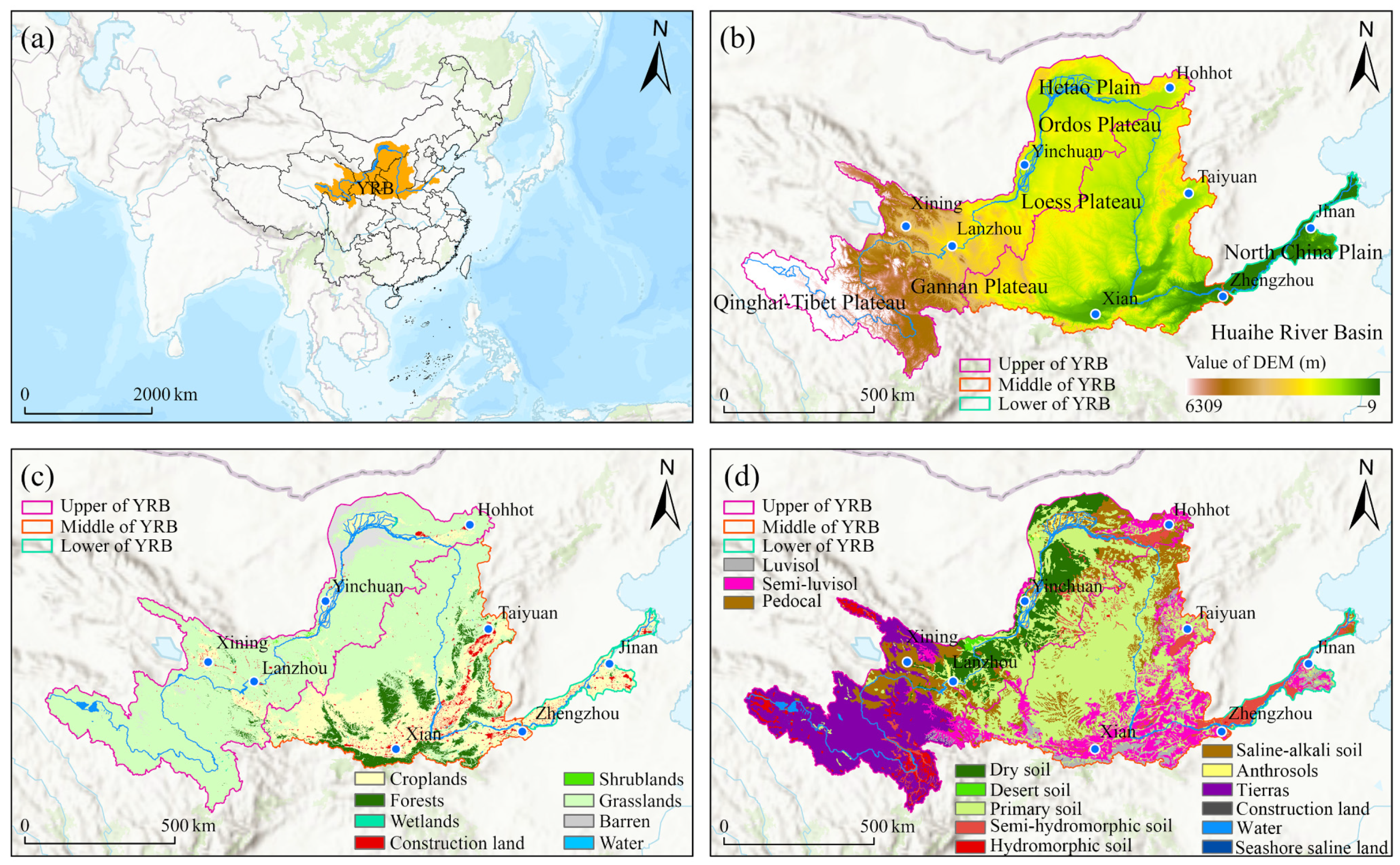
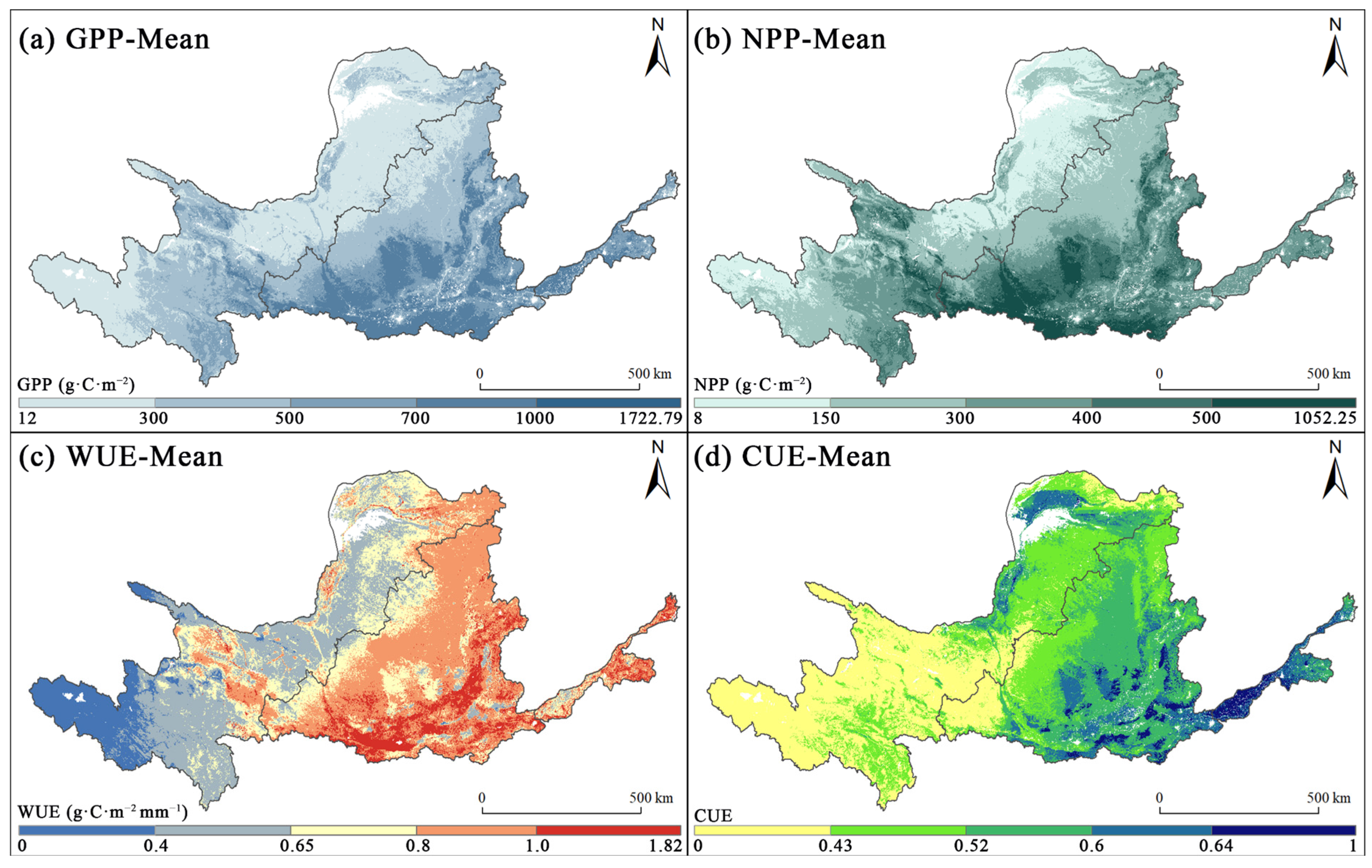


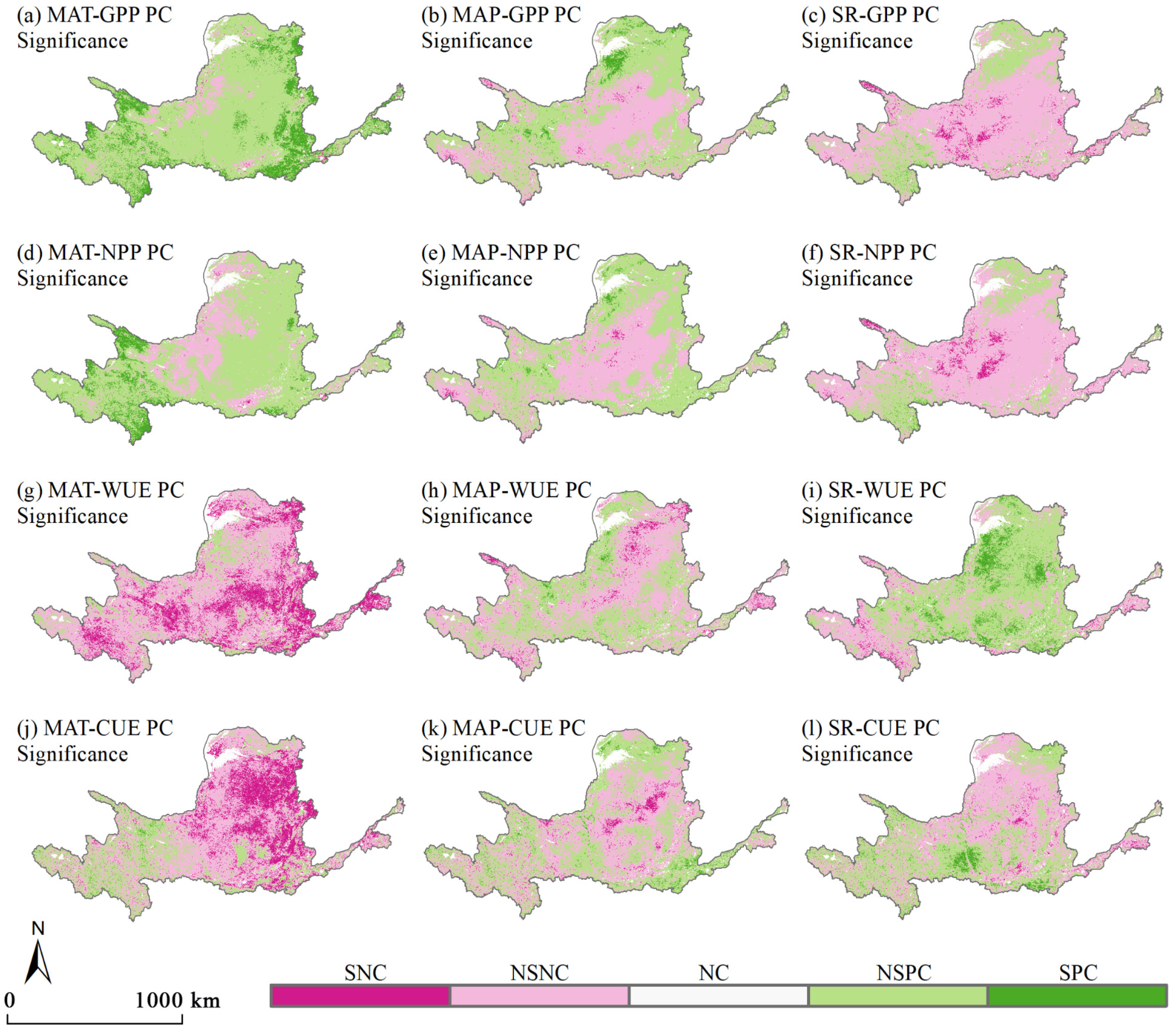
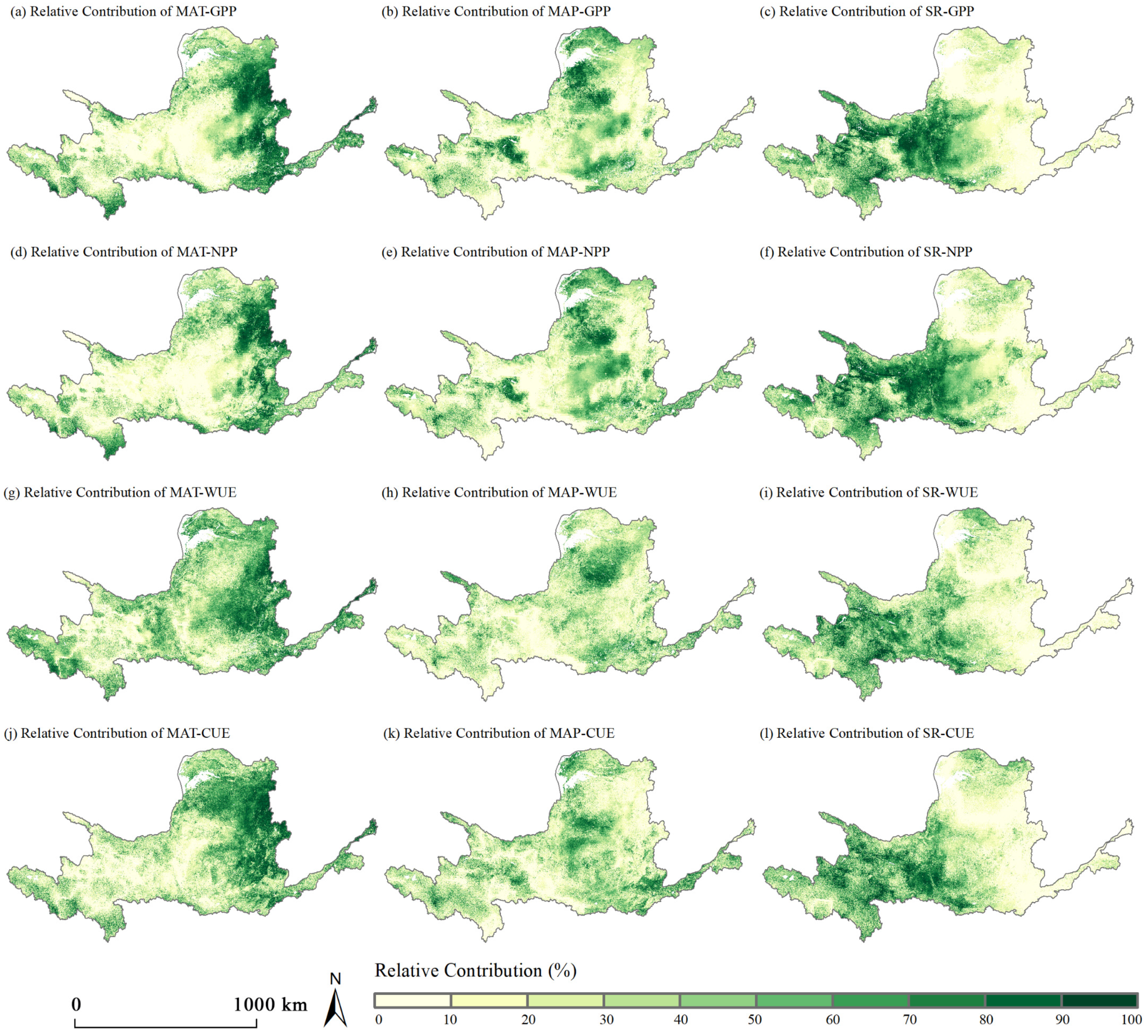
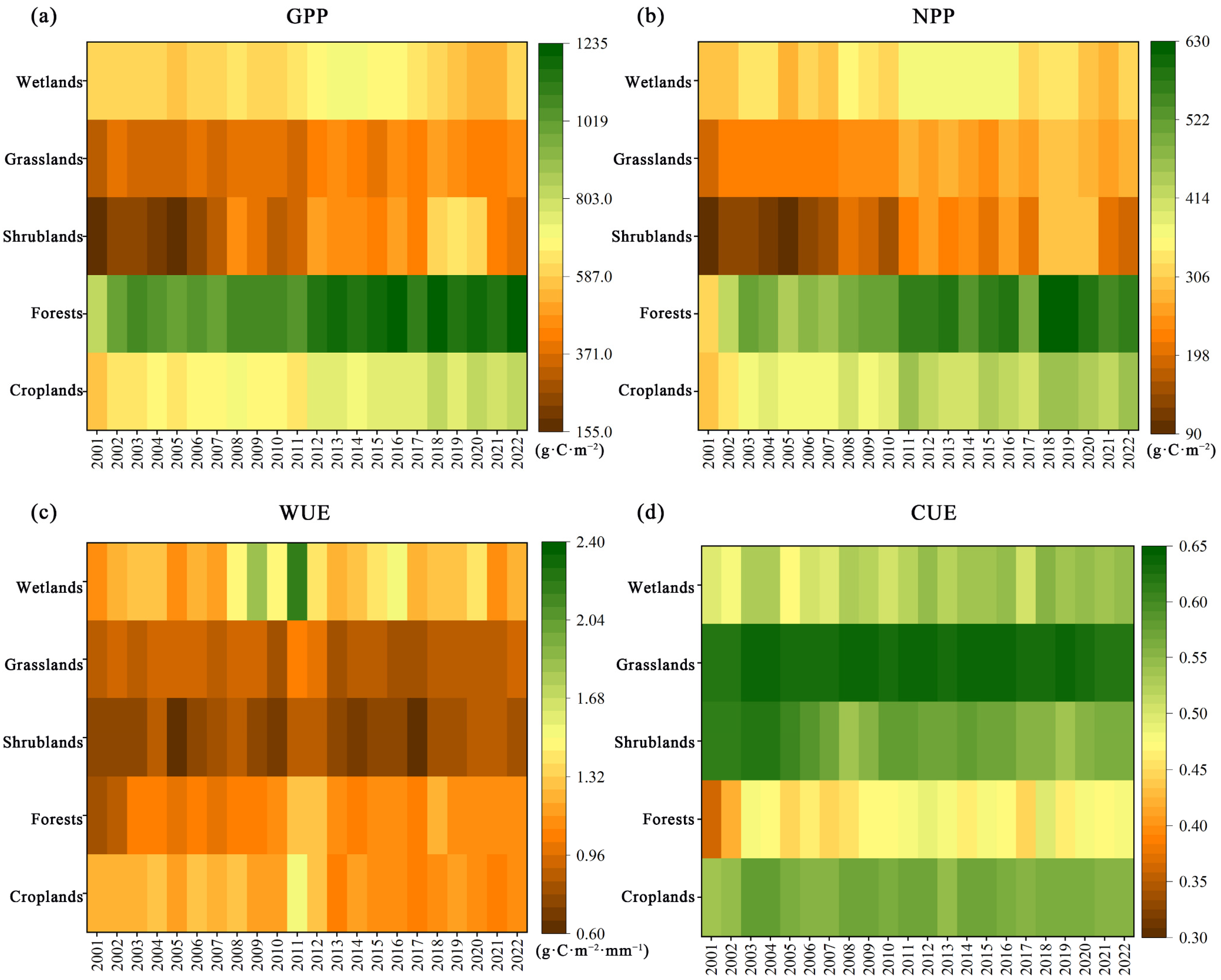
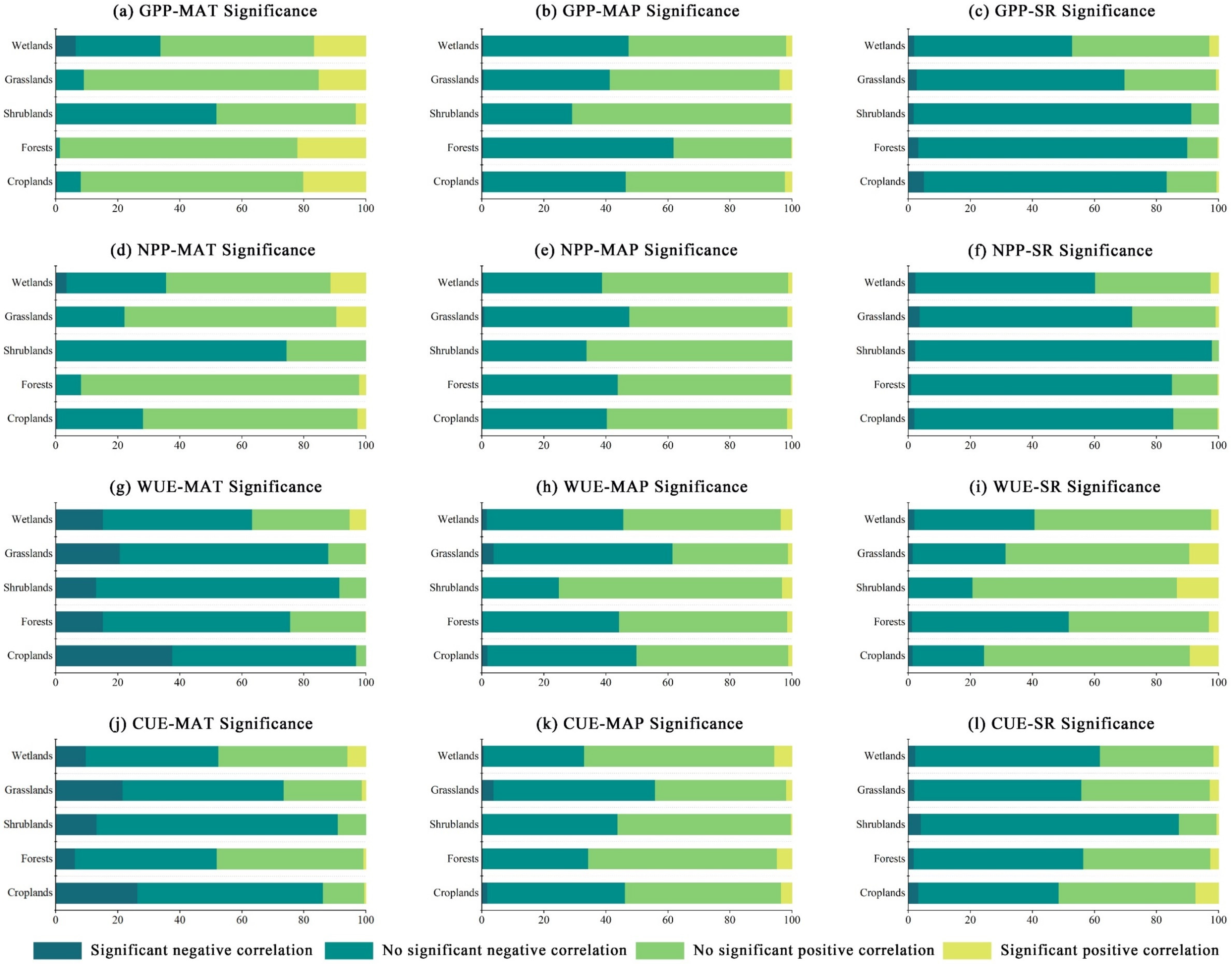
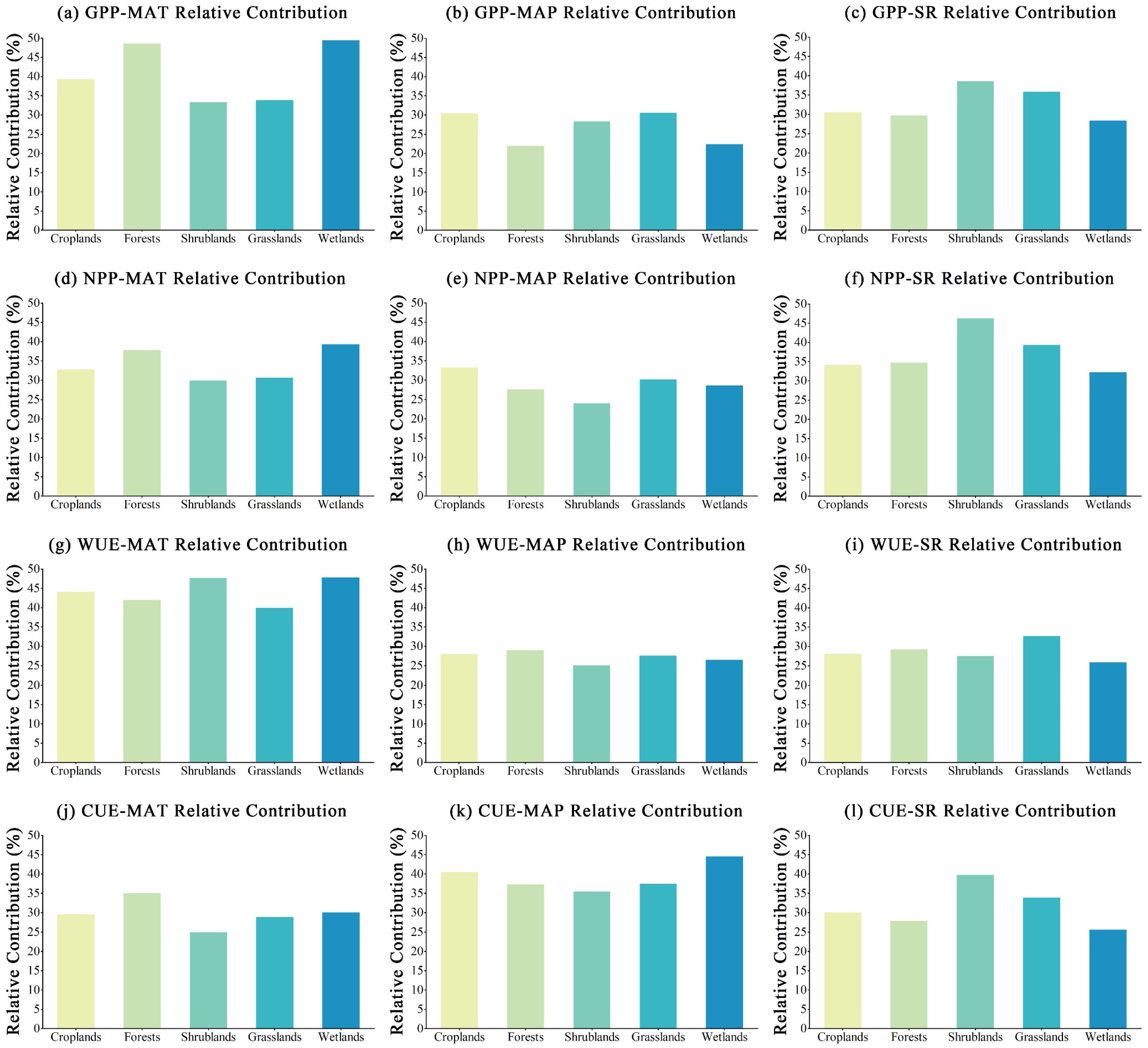
| Types | Date | Time Resolution | Spatial Resolution | Source | Download Site |
|---|---|---|---|---|---|
| NPP | 2001–2023 | Annual | 500 m | MOD17A3HGF | https://earthengine.google.com/ (accessed on 7 April 2025) |
| GPP | 2001–2023 | 8 days | 500 m | MOD17A2HGF | |
| ET | 2001–2023 | 8 days | 500 m | MOD16A2GF | |
| Land use | 2001–2022 | Annual | 500 m | MCD12Q1 | |
| Temperature | 2001–2023 | Daily | 0.1° × 0.1° | ERA5 Daily Aggregates | |
| Precipitation | 2001–2023 | Daily | 0.1° × 0.1° | ERA5 Daily Aggregates | |
| Solar radiation | 2001–2023 | Daily | 0.1° × 0.1° | ERA5 Daily Aggregates |
Disclaimer/Publisher’s Note: The statements, opinions and data contained in all publications are solely those of the individual author(s) and contributor(s) and not of MDPI and/or the editor(s). MDPI and/or the editor(s) disclaim responsibility for any injury to people or property resulting from any ideas, methods, instructions or products referred to in the content. |
© 2025 by the authors. Licensee MDPI, Basel, Switzerland. This article is an open access article distributed under the terms and conditions of the Creative Commons Attribution (CC BY) license (https://creativecommons.org/licenses/by/4.0/).
Share and Cite
Tang, X.; Cai, L.; Du, P. Differentiated Climate Drivers of Carbon and Water Use Efficiencies Across Land Use Types in the Yellow River Basin, China. Land 2025, 14, 1614. https://doi.org/10.3390/land14081614
Tang X, Cai L, Du P. Differentiated Climate Drivers of Carbon and Water Use Efficiencies Across Land Use Types in the Yellow River Basin, China. Land. 2025; 14(8):1614. https://doi.org/10.3390/land14081614
Chicago/Turabian StyleTang, Xianglong, Leshan Cai, and Pengzhen Du. 2025. "Differentiated Climate Drivers of Carbon and Water Use Efficiencies Across Land Use Types in the Yellow River Basin, China" Land 14, no. 8: 1614. https://doi.org/10.3390/land14081614
APA StyleTang, X., Cai, L., & Du, P. (2025). Differentiated Climate Drivers of Carbon and Water Use Efficiencies Across Land Use Types in the Yellow River Basin, China. Land, 14(8), 1614. https://doi.org/10.3390/land14081614






